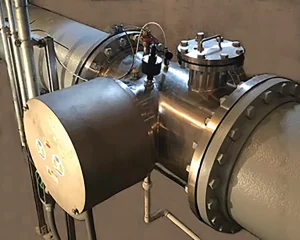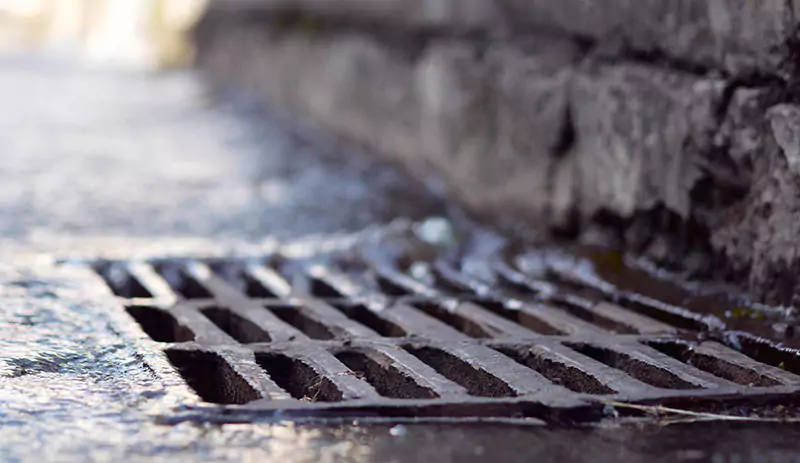Patrick Bollman, P.E.
UV product specialist, Evoqua Water Technologies
According to a study released by Water Resources Research1 in June 2019, heavy downpours have become more common since the middle of the last century, especially in North America, Europe and Asia. More frequent heavy rain will have implications up and down the ecosystem, from farmers contending with delayed plantings and flooded fields to communities grappling with the effects of high rivers, landslides and flooded sewers.
Flooded sewer events have become a growing concern for the more than 850 communities2 in the US that have a combined sewer system, in which a city’s wastewater and stormwater drain into the same treatment system. Under normal circumstances, this system works exactly as intended: rainwater, domestic sewage and industrial wastewater are all treated appropriately. But during peak flow events – such as a hurricane or tropical storm or even a sudden rush of snow melt – the flow can exceed the hydraulic capacity of the wastewater treatment plant or the collection system that transports the flow to the plant. Mature communities and cities, which have large amounts of concrete, asphalt and other impermeable surfaces, also have fewer places for that water to go. The result? Untreated overflow into a nearby body of water.
These overflows – called combined sewer overflows (CSOs) – are a priority water pollution concern for communities with combined sewer systems3; they contain a variable mix of untreated human and industrial waste, water polluted by running over city surfaces, and debris and scoured materials that build up in the collection system during dry weather periods. Combined, that water contains chemicals, pathogenic microorganisms, viruses and other pollutants that can adversely affect water quality and human and wildlife health.
Disinfection methods: chlorine vs. UV
Because wastewater has so much potential to increase pollutant levels and even spread disease, disinfection procedures are imperative. Traditionally, most municipalities use chlorine for disinfection because of its effectiveness and flexibility of supply, from chlorine gas to chlorine compounds in solid or liquid form. It’s cost-effective, reliable and well established.
However, chlorine treatment methods have their drawbacks. In addition to the danger potentially caused by any improper storage, shipping or handling, chlorine residuals are toxic to aquatic life even at low concentrations. Moreover, when chlorine is added to wastewater, it can alter organic matter by forming disinfection byproducts that can be dangerous themselves. Recognizing the toll on both the environment and on long-term public health, the EPA has established regulations governing residual chlorine limits and disinfection by-products.
Chlorine control is also difficult during CSO events. Like many chemical disinfectants, chlorine treatments must be calibrated to the amount and quality of the water being treated. CSO events, however, occur intermittently and vary widely in flow rate, which makes it difficult to strike the correct balance between disinfectant and flow. In order to cope with stormwater’s high flows, high suspending solids volume and variable temperature, chlorine systems can require4 long contact times. In addition, some CSO outlets are in remote areas that may require automated disinfection systems.
To avoid chlorine’s complexities, many municipalities are turning to UV disinfection. An estimated5 1 billion gallons of stormwater and wastewater per day are being treated with UV disinfection in North America, Europe, Asia and Australia. Unlike chemical treatment processes, UV disinfection only applies light to water, altering the DNA of pathogenic organisms – such as E. coli, salmonella and the rotavirus, and the bacteria that cause cholera and typhoid fever, respectively – to prevent replication without adding anything further to the water.
UV treatment also is capable of inactivating Giardia and Cryptosporidium, two pathogens of concern. Unlike chlorine methods, UV disinfection does not create any chlorinated by-products and does not require chemical storage or metering pumps to be effective. Additionally – and critically for the unpredictability of CSOs – UV disinfection’s effectiveness is not reliant on water temperature or pH.
For systems with finite footprints, UV also requires less space than a chlorine system would. Because there are no additives, UV disinfection eliminates the need for (and the risk of) handling and storing toxic and corrosive chemicals. The equipment itself – medium-pressure lamps in closed vessel reactors – also has a smaller footprint and a quicker start-up time.
Testing the efficacy of a UV system also has become straightforward, thanks to the advent of bioassay techniques, which have been well established for drinking water and are now being evaluated for wastewater testing. A bioassay test introduces nonpathogenic organisms into the fluid stream before it hits the UV system. System variables, including flow, power loads, water transmittance and lamp intensity, are all carefully calibrated and recorded, and water samples are taken before and after the water is disinfected. From there, the samples are sent to an analyzing laboratory, and the system’s ability to disinfect can be compared to the manufacturer’s specifications.
As with all systems, UV disinfection performs better under some circumstances than others. The right UV intensity must be applied to the water for enough time to destroy the pathogens – and suspended solids absorb and scatter UV rays. Low-quality stormwater can have high levels of total suspended solids (TSS), requiring municipalities to factor that into the amount of UV equipment/power that is required to properly treat the water.
UV system design
By their nature, CSOs can be more unpredictable than typical water flows, both in flow rate and in composition. Before a system is put in place, analysis should be done to determine the water quality that the UV system would need to treat so that the correct equipment can be put in place.
There are two generic designs available for UV disinfection: noncontact, which suspends lamps away from the wastewater, and contact, which uses lamps encased in a quartz sleeve or thimble that is submerged at all times. There are two main types of contact designs: open channel (both horizontal and vertical) and closed vessel.
An open channel system typically submerges lamps arranged parallel to the horizontal water flow, suspended from a self-supporting stainless-steel structure. While initially effective, this design has some significant drawbacks. Water level and speed control are vital to this system’s success, which is often achieved through a sliding gate mechanism. However, these mechanisms are prone to blockage and require frequent maintenance. If the channel is undersized in any way, the water will move through the system too quickly for proper disinfection – a problem made even worse if the channel is designed for typical weather flows and not peak wet weather flows.
Channel design can also create dead zones, which leads to short circuiting (a water layer above the lamps) and pockets of untreated water, and head-loss and overflow problems caused by flow straighteners. Finally, open channel systems can lead to burned skin or eyes or inhalation risks of airborne enteric viruses if proper precautions are not taken by operators.
Given these drawbacks, closed vessel systems have emerged as a newer technology poised to replace older systems and utilized in new UV disinfection systems. This method puts UV lamps in a sealed disinfection chamber that can be used in gravity or pressurized systems. The closed pipe protects the operator from being exposed to wastewater and UV light alike, and generally uses fewer lamps and consumable components in a smaller footprint, frequently reducing capital and/or operating costs of the project. UV chambers can be installed directly into a pipe network, eliminating the need for concrete channels and making it easy to retrofit the technology into already existing open channels or chlorine contact basins.
UV disinfection in action

The city of Rushville, Indiana, is in a rural area southeast of Indianapolis. Like 120 other communities in the state, Rushville has a combined sewer and often experienced CSOs in extreme weather situations. Because its system was not originally designed to treat stormwater in addition to wastewater, the flow would exceed the hydraulic capacity of the wastewater treatment plant, forcing the plant to bypass untreated wastewater, which would discharge into the nearby Flat Rock River, which is part of the watershed of the Mississippi River. Because of these discharges, Rushville was found to be in violation of the Clean Water Act.
The Indiana Department of Environmental Management granted Rushville 15 years to eliminate the overflow with milestones that it needed to meet every five years. In order to meet those milestones, Rushville reexamined its wastewater treatment protocols. Like many municipalities, it had been using a chlorine disinfection system, but the growing awareness of the adverse environmental impacts caused by chlorine and its by-products has led to increasingly restrictive chlorine residual requirements that are difficult to meet. Rushville decided to replace its chlorine system with a UV system to realize the benefits of reduced risk to plant operators and the surrounding environment and more effective elimination of chlorine-resistant pathogens such as Giardia and Cryptosporidium.
Rushville chose a closed vessel ETS UV system to treat the plant’s wastewater and its CSOs, making any excess water discharge into the river safe. Rushville chose this system because of its compact design, which makes routine maintenance easier; unique product features, such as low-voltage automatic wipers to keep quartz sleeves clean and reduce fouling; and a short lead time from purchase order to delivery to site.
Because of the nature of closed vessel systems – and the fact that it did not need any new structures constructed – the entire project was designed to minimize cost and impact to ratepayers. Critical for Rushville’s CSO needs, the system is fully automated to respond to variable flow and water quality without wasting any energy.
“The combination of solutions we selected to mitigate the risk associated with CSOs is the first of its kind in the state of Indiana,” said Les Day, city utilities facility manager. “The compact design of the ETS-UV disinfection system did not require the addition of a structure to house the equipment. Receiving effective disinfection without the use of chemicals allows us to put our best foot forward to protect the Flat Rock River.”
To achieve optimal results, Rushville’s system also included the application of cloth-media disk filters (CMDFs) – making it the first completed project in the US to use CMDFs combined with UV disinfection for CSO treatment. The filters serve two main purposes: improve transmittance of the wastewater/stormwater and reduce the total suspended solids. Suspended solids can shield or embed coliforms as they pass by the UV lamps, thus reducing the effectiveness as these coliforms will not be exposed to the UV light.
Thanks to these results, Rushville met its CSO compliance schedule five years early and met the future lower phosphorous discharge limits three years early. In recognition of these results, the city of Rushville – along with Donohue, the engineers behind the project, and Bowen, the general contractor – received a 2018 Merit Award for engineering excellence from the American Council of Engineering Companies (ACEC) of Indiana.
Today, Rushville’s system remains operational, and the city remains on track to meet its compliance schedules.
Conclusion
Untreated CSO events present a real environmental hazard surrounding overflow sites, and the risk of CSO events is likely to increase over the coming years. To avoid adverse environmental impacts and censures from local environmental protection agencies, municipalities are reevaluating the methods they use to ensure that upsets from CSO events are mitigated.
Contact Patrick Bollman, patrick.bollman@evoqua.com
References
- Papalexiou, S. M., & Montanari, A. (2019). Global and Regional Increase of Precipitation Extremes under Global Warming. Water Resources Research,55(6), 4901-4914. doi:10.1029/2018wr024067
- Combined Sewer Overflows (CSOs). (2018, August 30). Retrieved August 2, 2019, from https://www.epa.gov/npdes/combined-sewer-overflows-csos
- Combined Sewer Overflows (CSOs). (2018, August 30). Retrieved August 2, 2019, from https://www.epa.gov/npdes/combined-sewer-overflows-csos
- Disinfecting CSO Water. (2012, March). Retrieved August 2, 2019, from https://www.tpomag.com/editorial/2012/03/disinfecting_cso_water
- Pasalari, H., Ataei-Pirkooh, A., & Aminikhah, M. (october 2019). Assessment of airborne enteric viruses emitted from wastewater treatment plant: Atmospheric dispersion model, quantitative microbial risk assessment, disease burden. Environmental Pollution,253, 464-473. doi:https://doi.org/10.1016/j.envpol.2019.07.010






